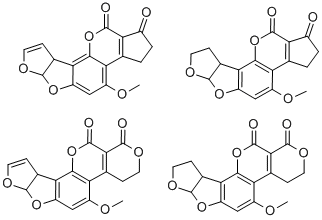
афлатоксин
- английское имяAflatoxin
- CAS №1402-68-2
- CBNumberCB21041503
- ФормулаC17H14O6.C17H14O7.C17H12O6.C17H12O7
- мольный вес1285.13
- номер MDLMFCD00084810
- файл Mol1402-68-2.mol
химическое свойство
| МАИР | 1 (Vol. Sup 7, 56, 82, 100F) 2012 |
| Система регистрации веществ EPA | Aflatoxins (1402-68-2) |
| РИДАДР | 3172 |
| Класс опасности | 6.1(a) |
| Группа упаковки | I |
| Банк данных об опасных веществах | 1402-68-2(Hazardous Substances Data) |
| Токсичность | human,LDLo,oral,229ug/kg/8W (0.229mg/kg),GASTROINTESTINAL: ULCERATION OR BLEEDING FROM SMALL INTESTINELIVER: "JAUNDICE, OTHER OR UNCLASSIFIED"BEHAVIORAL: ANOREXIA (HUMAN,Lancet. Vol. 1, Pg. 1061, 1975. |
афлатоксин химические свойства, назначение, производство
Описание
Aflatoxins are naturally occurring bisfuranocoumarin compounds produced from the molds Aspergillus flavus and Aspergillus parasiticus. The aflatoxins are highly fluorescent. The B refers to blue and the G signifies green fluorescence. M aflatoxins are fungal metabolites present in milk. Aflatoxin B1 is the most common and potent of the aflatoxins. Crops that are affected by aflatoxin contamination include cereals (maize, sorghum, rice, wheat), oilseeds (peanut, sunflower, soybean, cotton), spices (chili peppers, black pepper, coriander, turmeric, ginger), and tree nuts (almond, coconuts, brazil nuts, walnuts, pistachio). Aflatoxin can also be found in the milk, eggs, and meat from animals fed contaminated feed.Химические свойства
The aflatoxins are a group of molds produced by the fungus Aspergillus flavus. They are natural contaminants of fruits, vegetables, and grains. They are also described as a series of condensed ring heterocyclic compounds. They form colorless to pale yellow crystals. Practically insoluble in water.Использование
Aflatoxins are used solely for research purposes. They are naturally occurring contaminants formed by certain fungi on agricultural crops, first discovered in the 1960s (IARC 1976).Профиль безопасности
Confirmed human carcinogen with experimental tumorigenic data. Human poison by ingestion. An experimental teratogen. Other experimental reproductive effects. Mutation data reported. See also various aflatoxinsВозможный контакт
Aflatoxins are a group of toxic metabolites produced by certain types of fungi. Aflatoxins are not commercially manufactured; they are naturally occurring contaminants that are formed by fungi on food during conditions of high temperatures and high humidity. Most human exposure to aflatoxins occurs through ingestion of contaminated food. The estimated amount of aflatoxins that Americans consume daily is estimated to be 0.15 0.50 μg. Grains, peanuts, tree nuts, and cottonseed meal are among the more common foods on which these fungi grow. Meat, eggs, milk, and other edible products from animals that consume aflatoxincontaminated feed may also contain aflatoxins. Aflatoxins can also be breathed inКанцерогенность
Aflatoxins are known to be human carcinogens based on sufficient evidence of carcinogenicity from studies in humans. Aflatoxins were listed in the First Annual Report on Carcinogens as reasonably anticipated to be human carcinogens based on sufficient evidence of carcinogenicity from studies in experimental animals and limited evidence of carcinogenicity from studies in humans; however, the listing was revised to known to be human carcinogens in the Sixth Annual Report on Carcinogens in 1991.Экологическая судьба
Aflatoxin B1 is metabolized to a reactive epoxide (aflatoxin 8,9-epoxide) primarily by the P450 monooxygenase system. In humans, the epoxidation reaction is catalyzed by CYP1A2 and CYP3A4. Once formed, the epoxide can react further to form DNA adducts (aflatoxin-N7-guanine) and induce mutations and cancer. Alternatively, the epoxide can be detoxified by conjugation with glutathione through the actions of certain glutathione S-tranferases. Rats are more susceptible than mice to aflatoxin hepatocarcinogenesis even though both species form the reactive 8,9-epoxide at similar rates. Differences in species susceptibility are hypothesized to relate to increased rates of glutathione conjugation to the aflatoxin 8,9-epoxide in mice compared to rats.Перевозки
UN3172 Toxins, extracted from living sources, solid or liquid, Hazard Class: 6.1; Labels: 6.1-Poisonous materials, Technical Name Required. UN2811 Toxic solids, organic, n.o.s., Hazard Class: 6.1; Labels: 6.1-Poisonous materials, Technical Name Required.Несовместимости
Incompatible with oxidizers (chlorates, nitrates, peroxides, permanganates, perchlorates, chlorine, bromine, fluorine, etc.); contact may cause fires or explosions. Keep away from alkaline materials, strong bases, strong acids, oxoacids, epoxides.Утилизация отходов
Consult with environmental regulatory agencies for guidance on acceptable disposal practices. Generators of waste containing this contaminant (≥100 kg/mo) must conform with EPA regulations governing storage, transportation, treatment, and waste disposal. Use of oxidizing agents, such as hydrogen peroxide or 5% sodium hypochlorite bleach. Acids and bases may also be used.афлатоксин поставщик
| поставщик | телефон | страна | номенклатура продукции | благоприятные условия |
|---|---|---|---|---|
| +86-0551-65418671 +8618949823763 |
China | 34563 | 58 | |
| +8615373025980 | China | 895 | 58 | |
| 0571-82693216 | China | 9387 | 52 | |
| 0571-89903882 15990081639 |
China | 3656 | 58 | |
| 0571-0571-89903882 15990081639 |
China | 3705 | 58 | |
| 18153089275 | China | 22695 | 58 |